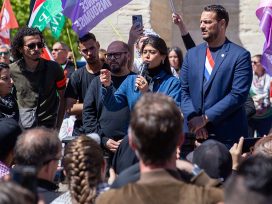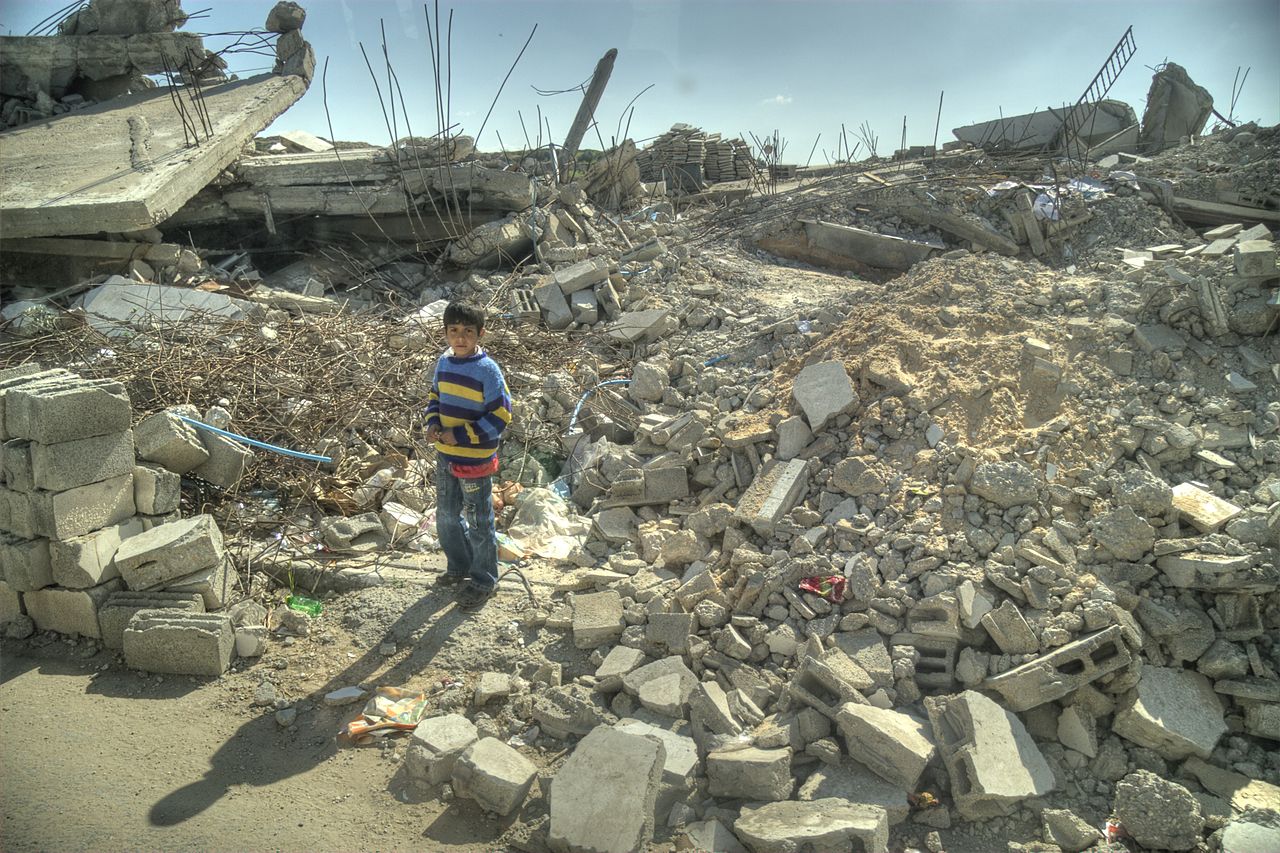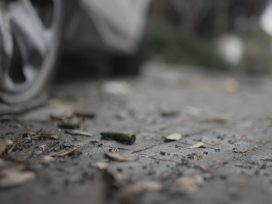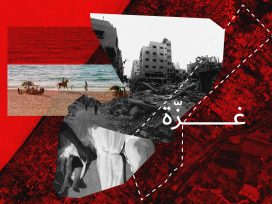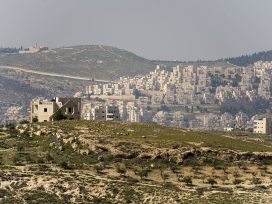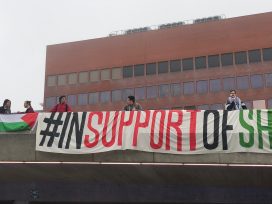‘It looks just like a lollipop,’ I vividly remember thinking to myself when looking at the military map, showing the long, ruler-straight paved road leading to the Jewish settlement of Netzarim in the Gaza strip. It was January 2001, four months after the breakout of the Second Intifada. I was one among thousands of Israeli reservist soldiers hastily mobilized.
Out of all places, I was sent to Netzarim: a tiny but notorious religious settlement south of Gaza city, a Jewish enclave between Arab populations, sitting at the end of a single, heavily guarded road serving as its artery.
‘What on earth am I doing here?’ was the immediate question that followed. Back then, I considered myself a centre-left Israeli patriot, a secular ‘liberal Zionist’, as they tend to be called in the Western media.
I felt alienated by the settlers’ brand of Jewish radicalism. I was willing to join the moderate Israelis who publicly voiced their empathy for the plight of Palestinian refugees in Gaza. Yet refusal to serve was then still out of the question. There was something unfathomable about someone like me being sent to a ‘shithole’ like that. What was I thinking to myself? How did I try to rationalize it?
The recent outburst of violence took me back to those past quandaries, reminding me of my last deployment in the Occupied Territories; there were subsequent calls of duty, but I refused to show up.
Political scientists, area specialists and security analysts alongside self-proclaimed conflict resolution experts and other pundits spill rivers of virtual ink to explain the causes and results of the last Israeli military operation in Gaza, codenamed Operation ‘Guardians of the Wall’. Some offer valuable insights by looking at the events from 20,000 feet; others cling to details, distractions that show the trees while overlooking the forest.
Not the rush of adrenalin
Where to begin the story remains a source of endless debate. Should it be Israel’s one-sided disengagement from Gaza in 2005? A couple of years after declaring that Netzarim was as important as Tel-Aviv, the then-Israeli prime minister Ariel Sharon had no qualms about ordering the removal of its residents. For obvious reasons, many return to the 1967 and 1948 wars instead. Some historians, including myself, turn back even further to pre-independence eras: the British mandatory period, World War I and even the late Ottoman period.
Sidelined in these discussions are the dynamics of popular sentiment that perpetuate systems of oppression: the intimate stories actors on the ground are told to make sense of violence and warrant it. Insufficient attention is given to the fact that the recent escalation of violence has followed a hideously familiar script.
My use of the word ‘script’ is intentional. A consistent feature of inflammable situations is that they function as a stage, with all the men and women merely as players. Violence is a potent emotional activator, running on the human desire for a world where good and evil can be clearly distinguished, on our innate and irrepressible desire to judge before we understand.
It is not the rush of adrenalin alone that is needed to switch into combat mode. It is the veiling of a highly patterned morphology of violence, the well-rehearsed routine with its timing, triggers, targets and precipitants.
It is the way that emotions are socially constructed, acquiring a social function and meaning within the framework of power and rule, which help produce and maintain what historians refer to as ‘emotional communities’ and ‘emotional regimes’. It is the uncompromising demand imposed on actors to play out their roles in a fabricated world where the binarisms of victim and perpetrator, friend and foe, civility and barbarity are never disputed, where one’s complicity and implication in systems of injustice are concealed, the steering of a plot so that responsibility and solidarity are only possible towards one’s community of blood.
From mere stunt to security concern
I was not the only one feeling frustrated and confused in late 2000. Violence had erupted a few months earlier, not long after the then Israeli prime minister Ehud Barak had returned from the US to inform the public about the resounding failure of negotiations at Camp David. At that time, Ariel Sharon, as leader of the opposition and a controversial icon of the Israeli Right, insisted on visiting the Temple Mount with an entourage of Likud party members and more than one thousand Israeli police officers.
An arrogant display of potential state power and Jewish sovereignty, the spite-visit led to a rapid flare-up. Palestinians, outraged by what they saw as a deliberate provocation, began throwing stones and rioting. The Israeli police stormed into the sacred site, killing four Palestinians (three more were killed in other parts of Jerusalem).
From there, violence spread across the country like fire in a haystack. Excessive force used to disperse demonstrations of Palestinian citizens of Israel resulted in thirteen deaths, adding fuel to the fire. The ‘green line’, the marker of the 1949 Armistice border separating the Occupied Territories from Israel, did not demarcate the borders of Palestinian solidarity. Suddenly, Sharon’s spite-visit, which was initially belittled, considered a mere domestic political stunt, turned into an issue of national security.
By January 2001, the Oslo peace process received its death blow when the last-ditch effort to reach an Israeli-Palestinian agreement in Taba collapsed. Horrified by increasing numbers of suicide bombings orchestrated by Hamas and Islamic Jihad against civilians, larger swathes of the Jewish-Israeli public echoed then Israeli prime minister Ehud Barak’s statements that the ‘days of the Palestinian partner have ended’ and that ‘the mask has been removed’ from Yasser Arafat’s face.
From there, the clock could no longer be turned back. Moved by shocking images of violence and narratives of betrayal, Israelis like me were mobilized. When I asked, ‘I am not a settler. I oppose their project. What on earth am I doing here in Gaza?’ these were the images that were shown to me, these were the stories that I was told.
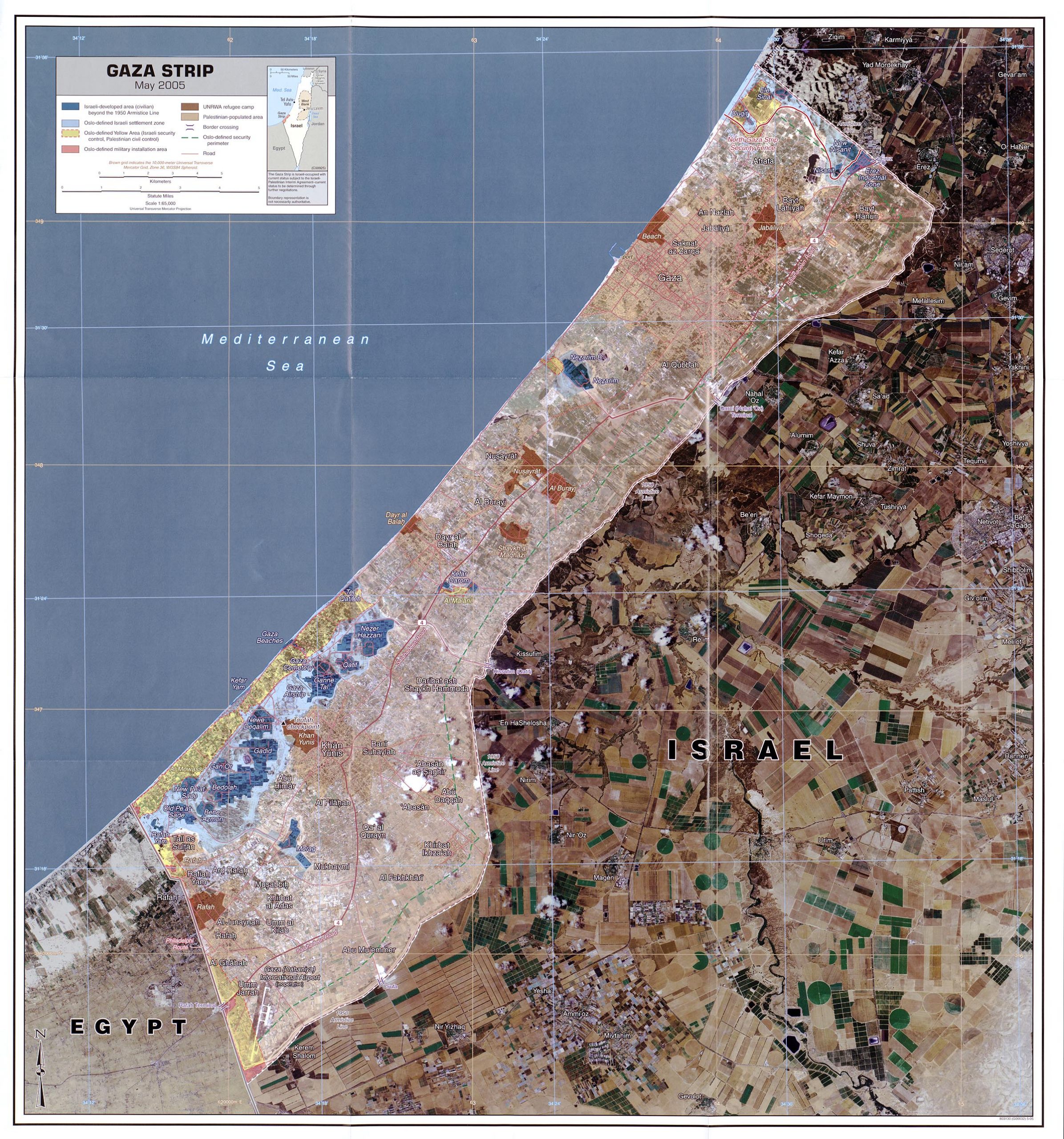
Satellite photo of the Gaza strip before the Israeli withdrawal, May 2005. Image via Wikimedia Commons.
A very familiar script
Fast-forward two decades: in May 2021, the chronicle of events followed a shockingly similar pattern, relying on the same Pavlovian response. During Act I, right-wing religious settlers appeared on the scene, this time determined to remove Palestinian residents from the East Jerusalem neighbourhood of Sheikh Jarrah, in walking distance from the Old City.
In the eyes of most Israeli-Jews, the issue was considered insignificant: a local, intricate real-estate dispute that had been dragging on for years. It interested no one besides the Palestinians, who highlighted how Israeli law only enabled Jews to ‘return’ to property abandoned during the 1948 War and saw how Israel had accelerated its expansion in the West Bank since 2000. They were joined by a small but determined group of Jerusalemite left-wing activists, who took this as a principled struggle against Israel’s discriminatory policy.
Prime Minister Netanyahu, a Houdini who had managed to stay in power throughout four election cycles in less than two years, despite being indicted for fraud, breach of trust and accepting bribes, had little to worry about: so much of his success is attributed to his ability to run smear campaigns against his rivals and convince his ‘base’ that an old ‘lefty’ hegemony is still running a ‘deep state’ and orchestrating a witch-hunt directed against him and his family. His populist demagoguery split Israel’s Jewish society into bitter rival groups – centre versus periphery, Left versus Right, Mizrahi (Jews of middle eastern and North African descent) versus Ashkenazi (those of European descent) – and it helped to portray those Jewish efforts supporting the Palestinian cause as the superficial virtue signalling of a privileged upper-class, funded by foreign, hostile agencies working against the populus. In such a toxic atmosphere, it was easy to dismiss left-wing activists, who opposed the settlers’ attempt to ‘Judaize’ Sheikh Jarrah, as radicals suspected of treason, even accused of auto-antisemitism.
During Act II, temperatures began to rise at the Temple Mount. In addition to the tensions caused by hundreds of Sheikh Jarrah residents facing eviction, Jerusalem’s chief of police ordered checkpoints and barricades to be placed at the Damascus Gate during Ramadan. Such a miserable, one-sided decision and departure from common practice provoked anger, which resulted in clashes with the police.
Within hours, a video posted on TikTok that showed East Jerusalemite teenagers slapping two Orthodox Jewish boys went viral, leading to violent processions of young Jews in central Jerusalem, and calls from leaders of Lehava, a far-right Jewish supremacist group, ‘to restore Jewish honour’ and attack Palestinians. Dozens of Palestinians were injured and dozens of demonstrators on both sides were arrested in clashes on 22 April.
As if this combination of events was not enough, on 29 April the Palestinian Authority (PA) announced that it would postpone Legislative Council elections due to Israel’s refusal to hold elections in East Jerusalem. It called on Palestinians to put pressure on Israel and the international community by mobilizing a popular non-violent protest. Israeli hawks spoke once again of ‘unmasking’, about the need to ‘remind’ Palestinians, as if they had forgotten, who’s sovereign.
In Act III, on 9–10 May, all guns hanging on walls were fired. The trigger was Jerusalem Day, the holiday commemorating ‘reunification’: the anniversary of Israel’s conquest of East Jerusalem and the Old City in the 1967 War. The commemorative day attracted thousands of religious settlers to the Old City. Thousands of Muslims were concurrently gathering nearby for Laylat al-Qadr – literally meaning ‘Night of Power’ – the most sacred moment of Ramadan, traditionally celebrated at the al-Aqsa mosque.
All the ingredients for religiously motivated ethnonationalist riots were there: the frustration and provocation that surround a crisis sliding around pomp and circumstance, the familiar flashpoints of vast processions. With so much tension in the air, a tree that caught fire at the al-Aqsa mosque compound was all that was needed to ignite an explosion of violence.
On Monday 10 May, the morning after, images of Jews dancing and chanting anti-Arab slogans while fire raged on Temple Mount were circulating and Israeli intelligence were alerted to a targeted attack: Hamas leaders in the Gaza Strip had decided to carry out their threat of launching a barrage of rockets on Jerusalem as a sign of solidarity with those Palestinians confronting Israel’s security forces. The Iron Dome anti-rocket battery, designed to protect Jerusalem from missile attack, was not deployed on time to intercept the six-rocket barrage that was fired at the capital.
The meltdown began: the next eleven days witnessed an escalation of violence that included heavy air force bombardments, the bombing of civilians alongside military targets, intense riots in Israel’s mixed cities, lynching on both sides, the arson of houses and synagogues.
Landlords and warlords
This was the chronicle of a death foretold, not a sudden earthquake nor an erupting volcano. By Anton Chekhov’s standards, it was a very predictable play. The landlords called upon the warlords, each behaving precisely as expected, following the script. Indeed, the chronicles of the last deadly skirmish provide a textbook example of what political scientists like Donald Horowitz and others see as the generic ‘deadly ethnic riot’.
One needs to be befuddled by Eurocentric prejudices to insist that the cognitive mechanisms and social dynamics that result in deadly Hindu-Muslim clashes in the Indian subcontinent, or the frequent escalations to carnage between Kyrgyz and Uzbeks in Central Asia, or anti-Tamil riots in Sri Lanka, could not transpire in the Israeli ‘start-up nation’.
Were the Israeli authorities so ignorant that they were incapable of seeing how they actively exacerbated an already tense situation, or was there something more sinister at play? As if re-enacting the legendary story of Emperor Nero, Caesar Netanyahu summoned emergency cabinet meetings and cast himself in his favourite role as ‘Mr. Security’, while unleashing hate and trying to dismantle his rivals’ negotiations for a coalition government without his party.
A battalion of military commentators – all middle-aged men, mostly retired officers – stormed Israeli television studios to expound the necessity to ‘rehabilitate deterrence’, accept the ‘duty to respond’ and use more force in the name of ‘law and order’. Israel’s apologetic supporters abroad were quick to respond, showing their solidarity by fighting an embarrassing PR war. Everyone followed the script quite dutifully.
The lawnmower doctrine
‘Complicated’ is the adjective that has been thrown around regularly over the last couple of weeks. The Latin complicāre meaning ‘folded together’, suggests something composed of interconnected parts that should be unfolded to be understood. As a colleague justly commented, it is only helpful to call a situation ‘complicated’ if one is committed to unfolding the package, willing to examine its contents and prepared to be surprised by what one finds hidden inside. If one takes comfort in just calling something complicated without unravelling the layers, then it will remain obfuscated.
For anyone who has closely followed the developments in Israel-Palestine over the last two decades, there isn’t much that is complicated here. The dynamics leading to recurrent, seasonal escalations are built into the twisted logic of ‘lawn mowing’, a euphemism that began circulating around the early 2010s to describe a strategy based on several principles: the understanding that the Israeli army (IDF) cannot defeat extremist guerrilla groups on the battlefield, the Israeli public cannot endure the thought nor the reality of heavy Israeli casualties and that, despite US backing, international pressure would not allow for long military campaigns.
In practical terms, the IDF is therefore tasked to maintain a suffocating blockade on Gaza – relying on aerial surveillance, a constant gathering of intelligence and occasional targeted killings – while continuing to treat the PA in the West Bank as a subcontractor of Israel’s security apparatus, not as a Palestinian proto-state.
Waiting for sparks or ‘trigger-events’ that would provide an excuse to launch military operations in Gaza with minimum Israeli casualties is an integral part of this doctrine. So far this century, five ‘lawnmowing’ blitz wars have already taken place in Gaza and the West Bank: Operation ‘Defensive Shield’ in Spring 2002, Operation ‘Cast Lead’ in winter 2008–09, Operation ‘Pillar of Defense’ in November 2012, Operation ‘Protective Edge’ in summer 2014 and, now, Operation ‘Guardians of the Wall’, or, as its critics sardonically call it, ‘Operation Guardians of the Walls of Balfour’, named after the street where Netanyahu lives.
The lawnmower doctrine has become synonymous with deterrence, a substitute for political and diplomatic negotiation, an excuse to invest millions of dollars in drones and rocket interception technologies rather than fighting inequities, discrimination and a system of oppression. These recurring seasonal operations are meticulously pre-planned but assume that even a successful operation could achieve nothing beyond a temporary respite between rounds of violence.
Indeed, while toppling civilian buildings in central Gaza is considered a legitimate target, toppling Hamas’s rule in Gaza is off the table. Provoking seasonal conflicts serves as an excuse to further the colonization of the West Bank, use a sophisticated combination of indirect military rule, establish emergency legislation and an exit permit regime to control it, and preclude any possible two-state solution.
Gadi Taub, an Israeli, alt-right-wing opinion writer, was quick to confirm this when tweeting to his followers: ‘Hamas must not collapse. Its terrorist infrastructure needs to be destroyed from time to time. But the split between it and the PA is good for us. The PA is more dangerous because it disguises itself as moderate, and we should not unite the Palestinians under its rule. It may one day realize that it should pretend to be moderate to establish a terrorist state in the heart of the country.’ A staunch Netanyahu supporter, Taub channels his master’s voice.
Playing for the camera
Lawnmowing has turned into a mindset, a philosophy of life and death. Indicators to measure its success are unclear: the ability to ‘damage terrorist infrastructure’ and ‘exact a heavy price’ is the official wording alongside the much-venerated ‘deterrence’.
In practice, for those who do not live in the Gaza Strip or the nearby Jewish towns and kibbutzim, the conflict has long ago turned into a media war, in which TV images are the real weapons. Whereas Israel previously accused enemies like Hezbollah of staging attacks for the camera, the Mavi Marmara/Gaza flotilla incident in May 2010 exposed Israeli army commandoes also ready to perform for the camera. It also revealed the ability of Israelis to navigate and negotiate images so that they don’t threaten their worldview.
The world saw a highly trained elite unit storming a civilian ship, in Hollywood-style action, killing nine human rights activists; the Israelis saw ‘our boys’ being beaten and humiliated by antisemites. Very few asked to lift the siege on Gaza after the incident. Even fewer asked why troops were employed to cinematic effect. In today’s toxic environment, these premises remain unexamined. In a war conducted by the IDF’s air force and spokesmen, senior Israeli commanders and politicians today openly express their thirst for a ‘victory image’: a photo of sublime horror, a spectacle of destruction.
A competition in victimhood
It is a cruel irony that state violence towards its citizens and subjects without basic rights is normalized once it is conceived as something akin to housekeeping, a metaphor that implies the characteristic rhythms and logic of ethnic cleansing. Nomenclature and debates about categorization matter to academics, but splitting hairs only serves as a distraction from the script.
Whether we use the term ‘Herrenvolk democracy’, ‘settler state’ or ‘ethnocracy’, the present dynamic is crystal clear: first, an Israeli security and control project over the area between River Jordan and the Mediterranean divides the Palestinian population into different groups, each of which grants Israel a varying level of legal rights and protections; and, second, it upholds a political regime that has abandoned the principle of equality to actively facilitate the expansion and control of the dominant Jewish ethnonational group in contested lands.
The Nation-State Law, which combines old and new policies and legislation that make non-Jews second-class citizens, frustrates processes of integration and piecemeal steps towards equity and equality in Israel. A ‘permit regime’ in the West Bank maintains segregation based on colonial emergency legislation and is considered one of the world’s most extreme and complex apparatuses for population management. The Gaza Strip also falls under Israel’s control from the outside; its residents depend on Israel as a prisoner depends on prison authorities.
Israel under Netanyahu invested millions of dollars each year on soft diplomacy and ‘Hasbara’ (literally: ‘explaining’) to camouflage the ugly reality. Emotional propaganda, which often quite cynically employs Jewish historical traumas and anxieties of annihilation, kicks in. Sacrosanct ‘security’ is at the heart of such wilful blindness towards the suffering of others.
Only a few Israeli political activists and intellectuals, committed to truth and reconciliation, are willing to support groups like Zochrot, an NGO fighting against the erasure of the Palestinian past, or engage with the work of Arab novelists like Elias Khoury, who appropriate terms like ‘ghetto’ to describe the Palestinian experience.
A zero-sum game, members of each side fear losing a monopoly on victimhood. Diaspora communities are pulled into this competition, also expected to follow the script.
The relentless effort to blur the distinction between antisemitism and the legitimate criticism of Israel and Zionist ideology becomes a central pillar of the strategy. This highly controversial move is not only counter-productive but dangerous, making the struggle against bigotry, racism, xenophobia and anti-Jewish violence outside Israel only more complicated. The group of scholars who crafted the JDA declaration sought to disentangle the two issues whilst acknowledging the alarming rise in levels of hostility towards Jews around the world.
After western observers and bystanders, the second most confused community is the group I used to be part of: secular liberal Zionists. We were raised on deeply embedded collective living, taking pride in our attachment to the land and its landscapes, the strong bonds of solidarity, altruism and the willingness of the individual to make sacrifices for the sake of the whole. Disgusted as many of us were by the religious zealotry of a minority we wanted to believe was insignificant, we nonetheless responded quickly to emergency calls to save a homeland in danger. Time and again, we failed to explain to ourselves and to the world why the tail is wagging the dog, how it could be that we were implicated and party to acts of injustice.
Israel is not the only state that must reckon with a history of land settlement and its enduring structural impacts on native or racialized populations. The challenge before progressive Jews is to develop a new language of solidarity that cuts across ethnocentrism and religious divides. Models of ‘coexistence’, which were hollowed out or are outdated, should be replaced by a non-violent co-resistance to occupation, xenophobia and settler-colonial policies that are invisible to so many Israeli-Jews until the fire breaks out. This can be done without dismissing the historical and religious connection Jews have with their presence in a contested land on the one hand, and without ignoring the asymmetry of power in Israel-Palestine today on the other.
Palestinians won’t miraculously disappear one day, nor will Jews emigrate en masse. Mutual anxieties of elimination constantly fuel the fire. Instead, we need to bring the new proposals and conversations about a federal, consociational (power-sharing) or confederal rearrangement of power to the fore.
Groups like Two States, One Homeland and numerous other grassroots initiatives, which the mainstream media ignores, the conservative and hyper-nationalists portray as traitors and too many liberals dismiss as naive utopians, should have a voice. As the historians in the room will be quick to note: many of their ideas echo pre-1948 conversations and proposals for a just solution for Palestine, including many that were proposed and advanced by Zionist activists who did not foresee a war that would turn them from a national minority into the masters of the land.
Recognizing the script could prevent Israelis and Palestinians from being propelled into instinctively taking roles in a prescribed play. Indeed, if the unbearable easiness of seasonal slaughter is disturbing, it’s time to write a new script.
